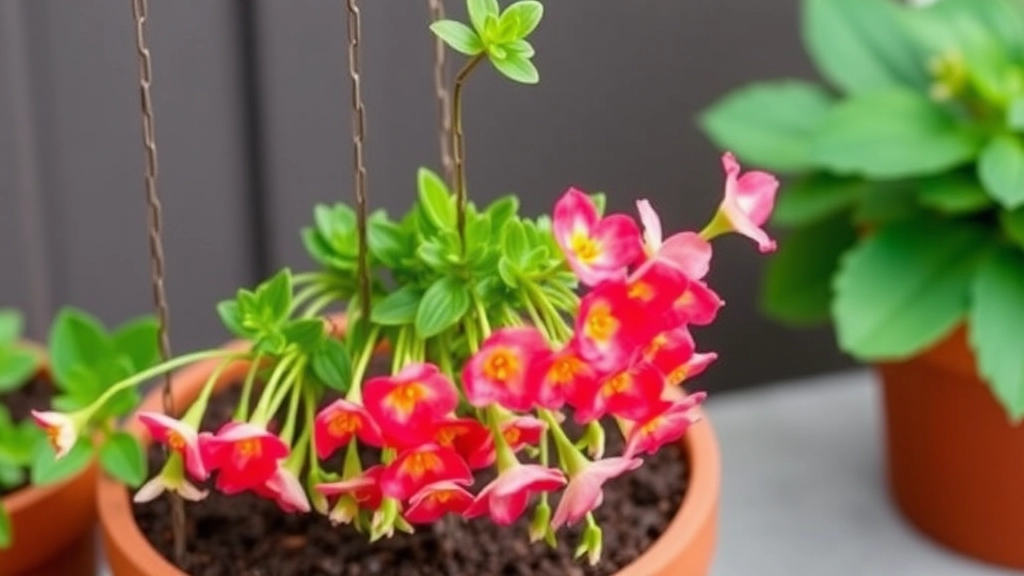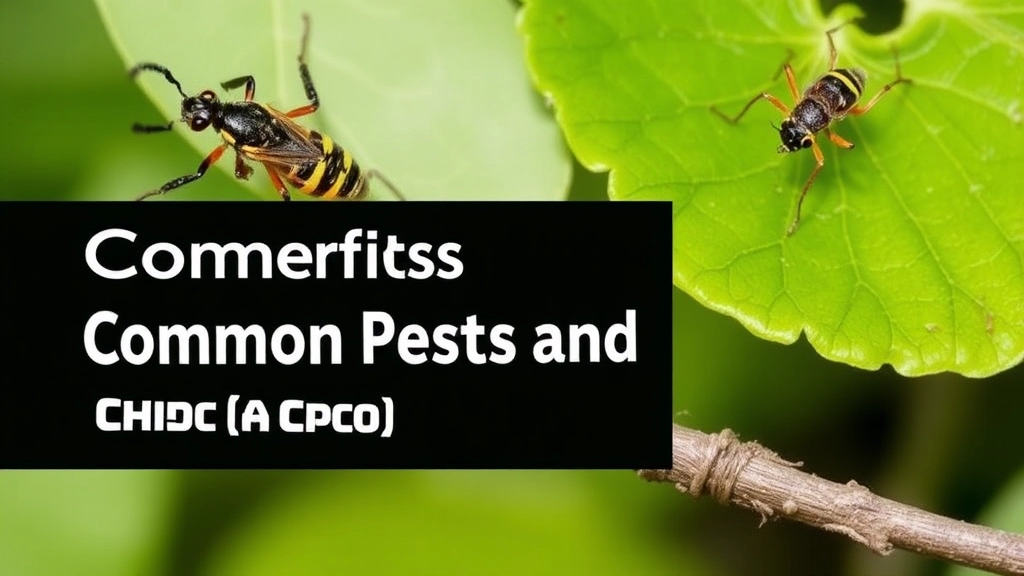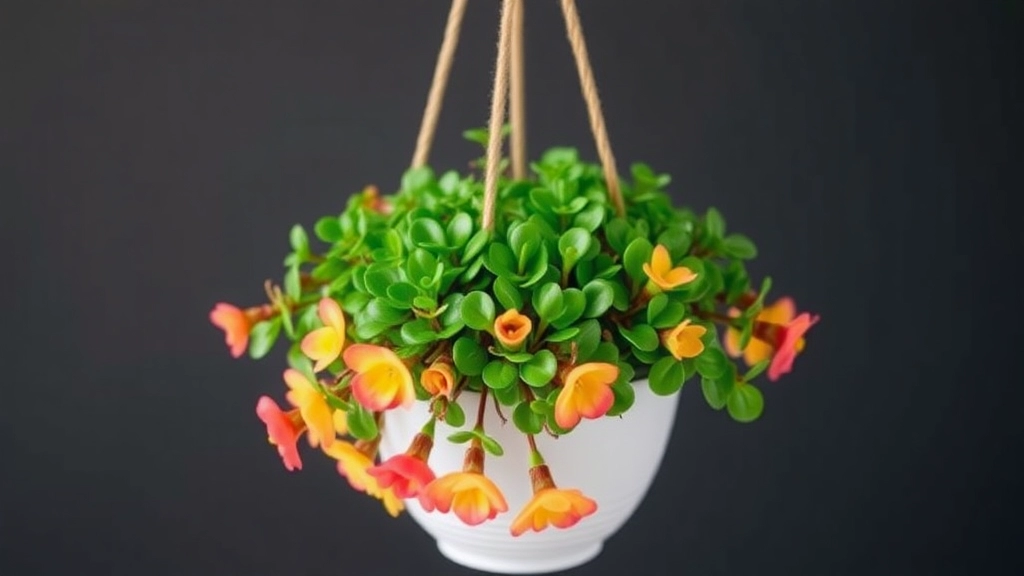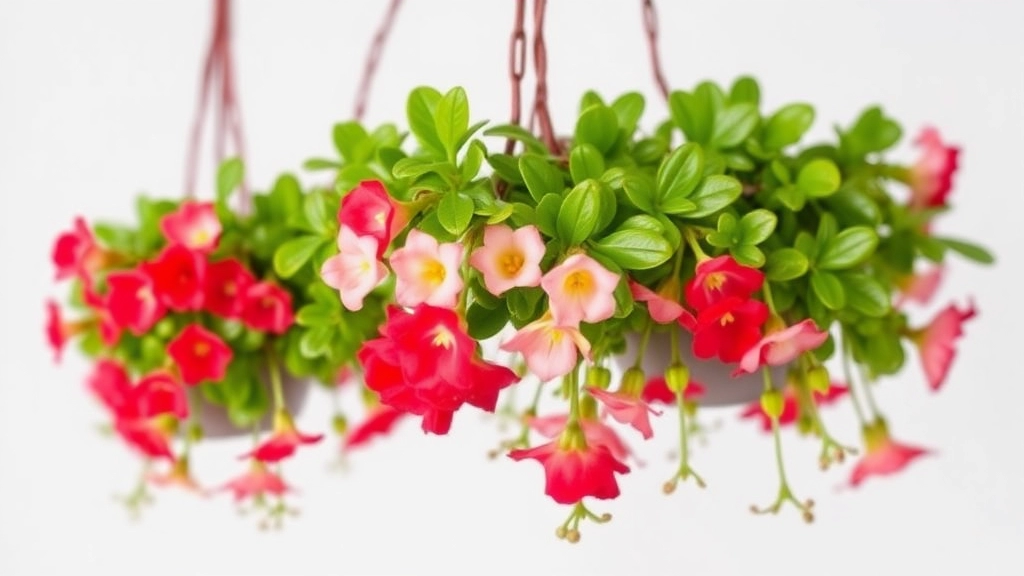Growing a Chandelier Plant Kalanchoe
When it comes to growing a Chandelier Plant Kalanchoe, simplicity is key. This unique succulent, known for its striking, cascading leaves, is a favourite among plant enthusiasts. Whether you’re a seasoned gardener or just starting, I’ll guide you through the essential steps to create the perfect environment for your Chandelier Plant Kalanchoe.
Essential Care Tips
First, let’s talk about light. Place your Kalanchoe in a spot where it can receive plenty of indirect sunlight. Too much direct sun can scorch the leaves, while too little light can stunt its growth.
Soil and Watering
Next, ensure your plant is in well-draining soil to prevent root rot. Water sparingly, allowing the soil to dry out between waterings. With these simple tips, your Chandelier Plant Kalanchoe will thrive and add a touch of elegance to your space.
Overview of the Chandelier Plant Kalanchoe
Are you searching for a unique and vibrant addition to your indoor garden? The Chandelier Plant, scientifically known as Kalanchoe, might just be the perfect choice.
This stunning succulent is renowned for its cascading leaves and eye-catching flowers, making it a popular choice among plant enthusiasts and decorators alike.
Kalanchoe is not just visually appealing; it is also relatively easy to care for, making it ideal for both novice and experienced gardeners.
Key Features of the Chandelier Plant Kalanchoe:
- Distinctive Appearance: Its unique, hanging foliage resembles a chandelier, hence the name.
- Variety of Species: There are numerous Kalanchoe species, each with its own characteristics and bloom colours.
- Drought Tolerance: Being a succulent, it is well-suited for those who may occasionally forget to water their plants.
In addition to its aesthetic appeal, the Kalanchoe offers several benefits that make it a valuable addition to any home. For those interested in maximizing the longevity of their plants, here are some essential care tips for maximizing longevity.
Identifying Features and Characteristics

So, you’re curious about the Chandelier Plant, or Kalanchoe, huh?
Let’s dive into what makes this plant so special.
Unique Appearance
- Leaf Structure: The Kalanchoe boasts thick, fleshy leaves that can be either smooth or slightly serrated. They often have a glossy finish, which adds a nice touch of shine to your space.
- Flowers: When in bloom, the plant showcases clusters of vibrant flowers. These can range from bright reds and yellows to soft pinks and whites. The blooms can last for weeks, making it a real showstopper.
- Growth Habit: Typically, the Chandelier Plant grows upright, reaching about 12 to 18 inches tall. Its branching structure gives it a bushy appearance, perfect for filling out a corner in your home.
Versatile Varieties
There are several Kalanchoe varieties to choose from, each with its own flair:
- Kalanchoe blossfeldiana: Known for its stunning clusters of flowers, this is the most popular variety.
- Kalanchoe tomentosa: This one has fuzzy leaves and a more compact form, adding a unique texture to your collection.
Care Indicators
Keep an eye out for these signs to ensure your Kalanchoe is thriving:
- Leaf Colour: Healthy leaves are a deep green. If they start to yellow, it could signal overwatering.
- Flowering: If your plant isn’t blooming, it might need more sunlight or a little extra care.
Personality Traits
Kalanchoe plants are quite forgiving, making them perfect for beginners.
They thrive on neglect, but a little love goes a long way.
Ideal Growing Conditions for the Chandelier Plant Kalanchoe
When it comes to nurturing your Chandelier Plant Kalanchoe, understanding its ideal growing conditions is key to ensuring vibrant growth and abundant blooms. You might be wondering, what environment does this plant thrive in? Let’s explore the essential elements that will help your Kalanchoe flourish.
Soil and Potting Requirements for the Chandelier Plant Kalanchoe

When it comes to nurturing your Chandelier Plant Kalanchoe, the right soil and potting conditions are crucial for its health and growth. You might be wondering, “What type of soil should I use?” or “How do I choose the right pot?” Let’s address these concerns.
Choosing the Right Soil
- Well-Draining Mix:
- Kalanchoe thrives in a well-draining soil mix.
- A cactus or succulent potting mix is ideal as it prevents water retention, which can lead to root rot.
- pH Level:
- Aim for a slightly acidic to neutral pH (around 6.0 to 7.0).
- This range supports optimal nutrient uptake.
- Additives:
- Consider adding perlite or coarse sand to enhance drainage.
- This will help maintain the right moisture balance.
Potting Considerations
- Pot Material:
- Terracotta pots are excellent as they allow air exchange and absorb excess moisture.
- Plastic pots can also work, but ensure they have drainage holes.
- Pot Size:
- Choose a pot that is slightly larger than the root ball.
- This allows for growth without overwhelming the plant.
- Repotting:
- Repot every 1-2 years or when you notice roots growing out of the drainage holes.
- This refreshes the soil and provides more space for growth.
As we dive deeper into caring for the Chandelier Plant Kalanchoe, understanding its watering and fertilization needs is crucial for its vibrant growth.
### Watering Requirements
One of the most common concerns for plant enthusiasts is how much water to give their Kalanchoe. Overwatering can lead to root rot, while underwatering can cause wilting. Here are some key points to consider:
– **Soil Dryness**: Allow the top inch of soil to dry out before watering again.
– **Watering Frequency**: During the growing season (spring and summer), water every 1-2 weeks. In the dormant period (autumn and winter), reduce frequency to once every 3-4 weeks.
– **Water Quality**: Use room temperature water, preferably rainwater or distilled water, to avoid chemicals found in tap water.
### Fertilization Needs
Fertilizing your Kalanchoe correctly can significantly enhance its growth and flowering. Here’s how to approach it:
– **Type of Fertilizer**: Opt for a balanced, water-soluble fertilizer, ideally one with a ratio of 10-10-10 or similar.
– **Frequency**: Fertilize every 4-6 weeks during the growing season. Avoid fertilizing in the dormant months.
– **Dilution**: Always dilute the fertilizer to half strength to prevent root burn.
For more detailed care instructions, you might find our [Chandelier Plant Kalanchoe care guide](https://planthq.org/chandelier-plant-kalanchoe-care-growth-and-propagation/) helpful. Additionally, if you’re interested in learning about watering tips for other varieties, check out our [optimal watering tips for healthy Florist Kalanchoe](https://planthq.org/optimal-watering-tips-for-healthy-florist-kalanchoe/).
Common Pests and Diseases

So, you’ve got your stunning Chandelier Plant, Kalanchoe, thriving beautifully. But what happens when those pesky pests or diseases come knocking at your door?
Pests to Watch Out For
- Mealybugs
These little white cottony bugs love to hide in the leaf joints. They suck the sap, which can weaken your plant.
Signs: Sticky residue, yellowing leaves.
Solution: Wipe them off with a cotton swab dipped in alcohol. - Aphids
Tiny green or black bugs that can cluster on new growth.
Signs: Curling leaves, stunted growth.
Solution: Spray with water or insecticidal soap. - Spider Mites
These are super tiny and can be tricky to spot. They thrive in dry conditions.
Signs: Fine webbing and speckled leaves.
Solution: Increase humidity and use neem oil.
Diseases to Keep an Eye On
- Root Rot
Overwatering is the main culprit here.
Signs: Wilting, brown roots.
Solution: Allow the soil to dry out and repot if necessary. - Powdery Mildew
This fungal disease appears as a white powder on leaves.
Signs: White spots and stunted growth.
Solution: Improve air circulation and avoid overhead watering.
Prevention Tips
- Inspect Regularly: Check your plant often for any signs of pests or diseases.
- Maintain Proper Watering: Don’t let your plant sit in soggy soil.
- Keep the Area Clean: Remove fallen leaves and debris from the pot.
Propagation Techniques for the Chandelier Plant Kalanchoe
As we delve deeper into caring for the Chandelier Plant Kalanchoe, understanding how to propagate this stunning succulent can be both rewarding and practical. Many plant enthusiasts wonder how to multiply their plants effectively without much fuss.
Common Propagation Methods
1. Leaf Cuttings:
This is one of the simplest methods.
– Select a healthy leaf from the parent plant.
– Allow it to dry for a few hours to form a callus.
– Place it on well-draining soil and mist lightly.
– Roots should develop within a few weeks.
2. Stem Cuttings:
Another popular method for propagation.
– Cut a healthy stem, ensuring it has a few leaves.
– Let it dry for a day or two.
– Plant it in soil, keeping it moist but not soggy.
– New growth will appear in a few weeks.
3. Offsets:
Chandelier Plants often produce offsets or pups.
– Gently remove the offset from the parent plant.
– Ensure it has some roots attached.
– Plant it in its own pot with suitable soil.
Tips for Successful Propagation
- Timing: Spring and summer are the best seasons for propagation, as the plant is actively growing.
- Environment: Keep cuttings in a warm, bright location but out of direct sunlight to avoid scorching.
- Humidity: A humidity dome or plastic bag can help retain moisture for cuttings.
By mastering these propagation techniques, you can expand your collection or share the beauty of the Chandelier Plant Kalanchoe with friends and family. For more detailed steps, you can refer to our step-by-step guide to growing Kalanchoe from leaf cuttings. Additionally, understanding how to grow Kalanchoe from leaves can also enhance your propagation success.
Seasonal Care and Maintenance of the Chandelier Plant Kalanchoe

So, you’ve got your Chandelier Plant Kalanchoe thriving, and now you’re wondering how to keep it in top shape throughout the seasons, right?
Spring Awakening
- Light: Increase sunlight exposure gradually. A south-facing window is ideal.
- Watering: Start watering more frequently as the plant grows. Just make sure the soil dries out between watering.
Summer Vibes
- Temperature: Keep it in a warm spot, ideally between 20-25°C.
- Fertilization: Feed it with a balanced liquid fertilizer every couple of weeks to encourage blooming.
- Humidity: If your home is dry, consider misting it occasionally or placing it on a pebble tray.
Autumn Prep
- Watering: Cut back on watering. The plant doesn’t need as much moisture.
- Pruning: Trim any dead or wilting leaves to keep it looking fresh.
Winter Care
- Light: Ensure it gets enough light. A grow light can work wonders if natural light is limited.
- Watering: Be careful not to overwater. The plant is dormant, so it needs less moisture.
- Temperature: Keep it away from drafty windows or heating vents.
Benefits and Uses in Home Decor
When considering the aesthetics of your home, the Chandelier Plant, or Kalanchoe, offers numerous advantages that can elevate your interior design.
Visual Appeal
The Chandelier Plant is renowned for its striking appearance. Its cascading leaves and vibrant flowers can serve as a stunning focal point in any room. Here are some key benefits:
- Versatile Styling: The plant complements various decor styles, from modern to rustic.
- Colour Variety: Available in multiple hues, it can match or contrast with your existing colour palette.
- Unique Texture: The fleshy, succulent leaves add a different texture to your decor, enhancing visual interest.
Air Quality Improvement
In addition to its aesthetic qualities, the Chandelier Plant contributes positively to indoor air quality.
- Natural Air Purifier: Like many succulents, it helps filter toxins from the air, creating a healthier living environment.
- Humidity Regulation: It can help maintain humidity levels, which is beneficial for overall comfort.
Low Maintenance
For those who may worry about the upkeep of houseplants, the Chandelier Plant is a low-maintenance option.
- Drought Tolerant: Its succulent nature means it requires less frequent watering.
- Resilient: It can thrive in various lighting conditions, making it suitable for different spaces.
Creative Display Options
The Chandelier Plant can be showcased in various ways, allowing for creativity in your decor.
Troubleshooting Common Problems with Your Chandelier Plant Kalanchoe
So, you’ve got your Chandelier Plant Kalanchoe, and it’s looking a bit off.
Maybe the leaves are drooping, or the vibrant colours are fading.
Don’t worry; we’ve all been there.
Let’s dive into some common issues and how to tackle them.
Leaf Drooping
What’s Happening?
Drooping leaves can be a sign of overwatering or underwatering.
Quick Fixes:
- Check the Soil: Stick your finger in the soil. If it’s soggy, hold off on watering.
- Adjust Watering Schedule: If the soil is dry, give it a good drink but don’t drown it.
Fading Colours
What’s Happening?
If your plant’s colours are looking dull, it might not be getting enough light.
Quick Fixes:
- Relocate Your Plant: Move it to a brighter spot, but avoid direct harsh sunlight.
- Rotate Regularly: This helps all sides get equal light exposure.
Leaf Spots
What’s Happening?
Spots on leaves could indicate pests or fungal issues.
Quick Fixes:
- Inspect for Pests: Check the undersides of leaves for little critters.
- Fungal Treatment: If it’s fungal, consider a neem oil spray to keep things in check.
Wilting
What’s Happening?
Wilting can be a sign of stress, often due to temperature changes or inconsistent watering.
Quick Fixes:
- Stable Environment: Keep your plant away from drafts and sudden temperature changes.
- Consistent Watering: Stick to a schedule to help it bounce back.
Root Rot
What’s Happening?
If your plant is wilting despite watering correctly, it might have root rot.
Quick Fixes:
- Inspect the Roots: Gently remove the plant from its pot and check for mushy roots.
- Repot with Fresh Soil: Trim off any rotten roots and place it in fresh, dry soil.
If you are looking for a detailed guide on how to care for this plant, check out our Chandelier Plant Kalanchoe Care Guide. For more tips on propagating different Kalanchoe species, you might find our Kalanchoe Tomentosa Propagation Guide useful.
FAQs About Chandelier Plant Kalanchoe
What are the identifying features of a Chandelier Plant Kalanchoe?
The Chandelier Plant, or Kalanchoe, is known for its thick, fleshy leaves that can be smooth or slightly serrated. It often has a glossy finish and showcases clusters of vibrant flowers ranging from bright reds and yellows to soft pinks and whites. The plant typically grows upright, reaching about 12 to 18 inches tall with a bushy appearance.
Are there different varieties of Kalanchoe?
Yes, there are several varieties of Kalanchoe. The most popular is Kalanchoe blossfeldiana, known for its stunning clusters of flowers. Another variety is Kalanchoe tomentosa, which has fuzzy leaves and a more compact form.
What soil is best for Kalanchoe plants?
Kalanchoe plants thrive in a well-draining soil mix. A cactus or succulent potting mix is ideal as it prevents water retention. Aim for a slightly acidic to neutral pH (around 6.0 to 7.0), and consider adding perlite or coarse sand to enhance drainage.
What type of pot should I use for my Kalanchoe?
Terracotta pots are excellent for Kalanchoe as they allow air exchange and absorb excess moisture. Plastic pots can also work, but ensure they have drainage holes. Choose a pot that is slightly larger than the root ball to allow for growth.
How often should I repot my Kalanchoe?
Repot your Kalanchoe every 1-2 years or when you notice roots growing out of the drainage holes. This refreshes the soil and provides more space for growth.
What are common pests that affect Kalanchoe plants?
Common pests include mealybugs, aphids, and spider mites. Mealybugs appear as little white cottony bugs and can be removed with alcohol. Aphids are tiny green or black bugs that can be sprayed off with water or insecticidal soap. Spider mites are very small and thrive in dry conditions; increasing humidity and using neem oil can help.
What diseases should I watch out for in my Kalanchoe?
Root rot and powdery mildew are common diseases. Root rot is often caused by overwatering and can be addressed by allowing the soil to dry out and repotting if necessary. Powdery mildew appears as a white powder on leaves and can be managed by improving air circulation and avoiding overhead watering.
How can I prevent pests and diseases in my Kalanchoe?
Regularly inspect your plant for any signs of pests or diseases. Maintain proper watering practices and avoid letting your plant sit in soggy soil. Keep the area around the plant clean by removing fallen leaves and debris.
What seasonal care does a Kalanchoe plant need?
In spring, increase sunlight exposure gradually and water more frequently as the plant grows. In summer, keep the plant in a warm spot, feed it with a balanced liquid fertilizer, and mist occasionally if the air is dry. In autumn, reduce watering and trim any dead leaves. In winter, ensure the plant gets enough light, avoid overwatering, and keep it away from drafty windows or heating vents.
References
-
Kalanchoe: How to grow and care for Kalanchoe
-
How to Grow Kalanchoe Indoors
-
Kalanchoe: Planting, Growing, and Caring for Kalanchoe
